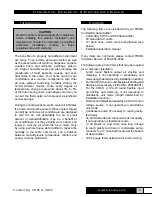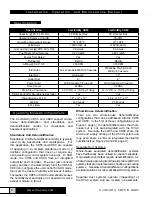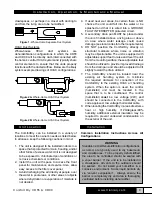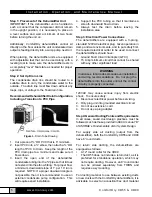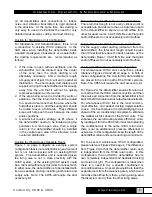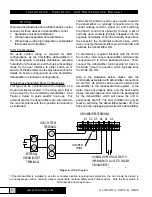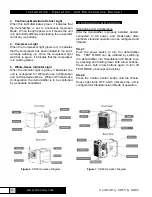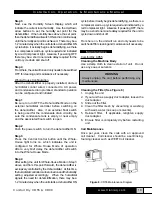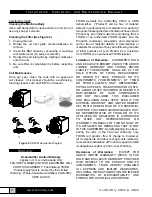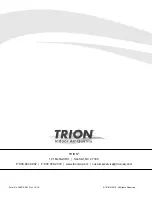
ComfortDry CD55 & CD90
I n s t a l l a t i o n , O p e r a t i o n , & M a i n t e n a n c e M a n u a l
www.trioniaq.com
6
on all dehumidifier duct connections to reduce
noise and vibration transmitted to rigid ductwork
in the structure. At the same time, flex ducting is
very easy to use and eliminates the need for very
detailed measurement, cutting, and duct forming.
Ducting for Standalone Unit Configuration
For Standalone Unit Dehumidification, there is not
a connection to existing HVAC ductwork. In the
SUD case, when installing the dehumidifier inside
a sealed crawlspace, a basement, or a sealed attic,
the ducting requirements are recommended as
follows:
1. If the area is open without partitions and the
dehumidifier can be located near the center
of the zone, then the return ducting is not
absolutely necessary. Still, a minimum length
of supply duct of just 3’ to 6’ will aid in overall air
distribution. The short supply duct distance will
support carrying the dehumidified air far enough
away from the unit that it will not be quickly
reprocessed again as returned air.
2. If the area being served is divided by walls or
partitions, then the return duct should be routed
to a second area/zone than the area where the
humidifier is placed - and the supply duct should
be routed to even a third area. These different
areas will help push the air between the walls
and/or partitions.
3. A similar but reverse strategy as #1 above, if
the dehumidifier needs to be located along the
perimeter in a more open zone, then a single
return to the dehumidifier should be installed
in the central open area of the structure to aid
overall air distribution.
Ducting for Whole-House Separate Room
Figure 1 on page 4 depicts an example system
configuration that is in a residential living environment
but is not interconnected with an existing HVAC
system. The dehumidifier unit is separated given
the living area is not in close proximity with the
HVAC system, or the existing HVAC system could
be a mini-split without any ductwork to connect with.
In either case, the dehumidifier is to be installed with
its own separate ducting, including both return and
supply side. Note: The CD55 will require the duct
accessory kit.
Return Ducting for Whole-House Separate Room
The return duct length is not overly critical, and it is
acceptable to provide more than a single return path
to the dehumidifier to improve overall airflow from
other far apart rooms. CAUTION: Be sure that grills
and/or diffusers do not excessively restrict airflow.
Supply Ducting for Whole-House Separate Room
For the supply output ducting (output air from the
dehumidifier), the total duct length should be less
than 10 feet total to reduce the back pressure on the
dehumidifier blower. CAUTION: Be sure that grills
and/or diffusers do not excessively restrict airflow.
Ducting for Whole-House HVAC Configuration
For whole-house HVAC duct connections, please
reference Figures 2A and 2B on page 4. In both of
these configurations, the ComfortDry dehumidifiers
are placed in the return path of the HVAC systems.
Note: The CD55 will require the duct accessory kit.
For Figure 2A, the dehumidifier sources its return air
connection from the HVAC return connection, and then
the source air connection from the dehumidifier is fed
back to the HVAC return air duct a few feet downstream.
For whole-house HVAC, this is the most common,
most effective, and easiest ducting implementation
to use. It is best because it is dehumidifying the air
ahead of the air conditioning coil system to eliminate
the wettest air first ahead of the HVAC coils. This
enhances the overall cooling system efficiency. Also,
by inputting air from the HVAC return duct and returning
the conditioned air to the same HVAC return duct,
there is not an additional air pressure differential to
overcome. In this configuration, keep the length of the
dehumidifier return and source ducting at a minimum.
For the second whole-house HVAC configuration,
please reference Figure 2B on page 4. The difference
from Figure 2A is that the dehumidifier return path
is independent from the HVAC return path. In this
configuration, the ComfortDry dehumidifier has its
own completely independent and dedicated ducting
and return air grill. This configuration is ideal when
there is a need to dry a specific conditioned or
unconditioned area. An example would be to feed the
separate room from the main living area, which would
maximize the airflow from there, proving a living area
that likely is more dry than the other living areas.



